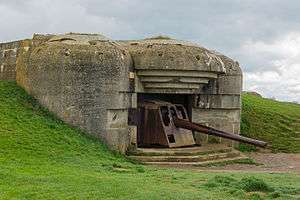Longues-sur-Mer battery
| Longues-sur-Mer Battery | |
|---|---|
| Part of Atlantic Wall | |
| Normandy, France | |
|
A gun emplacement at Longues-sur-Mer battery | |
|
Kriegsmarine Ensign | |
| Coordinates | 49°20′37″N 0°41′42″W / 49.3435°N 0.6950°W |
| Site information | |
| Open to the public | All casemates are open to public |
| Condition | Four casemates with artillery plus observation bunker |
| Site history | |
| Built | 1944 |
| Built by | Organisation Todt |
| In use | 1944 |
| Materials | Concrete and steel |
| Garrison information | |
| Garrison | Kriegsmarine |
The Longues-sur-Mer battery was a World War II artillery battery constructed by the Wehrmacht near the French village of Longues-sur-Mer in Normandy. It formed a part of Germany's Atlantic Wall coastal fortifications.
The battery was completed by April 1944.[1] Although constructed and manned initially by the Kriegsmarine, the battery was later transferred to the German army.[2] The site consisted of four 152-mm navy guns, each protected by a large concrete casemate, a command post, shelters for personnel and ammunition, and several defensive machine-gun emplacements.
Normandy landings
The battery at Longues was situated between the landing beaches Omaha and Gold.[3] On the night before the D-Day landings of 6 June 1944, the battery was subjected to a barrage comprising approximately 1,500 tons of bombs, although much of this landed on a nearby village.[4] The bombing was followed from 0537hrs on the morning of the landings by bombardment from the French cruiser Georges Leygues as well as the U.S. battleship Arkansas. The battery itself opened fire at 0605hrs and fired a total of 170 shots throughout the day, forcing the headquarters ship HMS Bulolo to retreat to safer water. Three of the four guns were eventually disabled by British cruisers Ajax and Argonaut, though a single gun continued to operate intermittently until 1900hrs that evening. The crew of the battery (184 men, half of them over 40 years old) surrendered to the 231st Infantry Brigade the following day. The heaviest damage was caused by the explosion of the ammunition for an AA gun, mounted by the British on the roof of casemate No.4, which killed several British soldiers.[5]
See also
External links
References
| Wikimedia Commons has media related to Atlantic Wall - Longues-sur-Mer. |
- ↑ "Wiederstandnest n° 48". The Atlantic Wall Linear Museum.
- ↑ D-Day Fortifications in Normandy. p. 28. ISBN 1-84176-876-6.
- ↑ Sterne, Gary (2014). The Cover-up at Omaha Beach. Skyhorse Publishing. p. 286. ISBN 9781629143279.
- ↑ "The Taking of the Longues Sur Mer Battery". Retrieved 28 June 2013.
- ↑ D-Day 1944. 2002. p. 50. ISBN 1-84176-368-3.

.svg.png)
.svg.png)